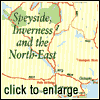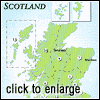|
North of Bonar Bridge
Bonar Bridge is the gateway to a relatively undiscovered
interior in this part of the Highlands. Following the A836 north, Carbisdale Castle
Youth Hostel at Invershin is a particularly well-appointed convenience for back-packers
exploring this part of the country where accents from most parts of Europe mingle
in such an imposing castle.
 Nearby are the Falls of Shin, a well known tourist stop with
a large coach park, gift shop and restaurant often with a young lady piper who appears
as soon as a well-laden coach pulls in. The falls, reached by a series of stairways,
are a major obstacle for migrating salmon that recklessly hurl themselves at the
torrent to reach their spawning grounds. Nearby are the Falls of Shin, a well known tourist stop with
a large coach park, gift shop and restaurant often with a young lady piper who appears
as soon as a well-laden coach pulls in. The falls, reached by a series of stairways,
are a major obstacle for migrating salmon that recklessly hurl themselves at the
torrent to reach their spawning grounds.
Five miles (8km) on, either following the minor road
or back-tracking to the slightly better A836, is the village of Lairg. While this
is no metropolis, it is a welcome outpost of civilisation for those that have just
taken the A836 south from Tongue or the A838 along Loch Shin from Laxford Bridge
and the north-west. They step out of their cars looking like they have just come
off a roller-coaster. The railway line north stops here at Lairg. It is a popular
holiday retreat with fishing, boating and walking in the hills behind the town. From
Lairg it is a pleasant drive back to the coast at Loch Fleet where you pick up the
A9 north or turn south to explore Dornoch.
Dornoch
First time visitors to the Edwardian town of Dornoch
may come expecting something more rugged and isolated in this northern zone, and
are pleasantly surprised to find an elegant, rather refined community in a setting
that would be equally fitting in Somerset or the Cotswolds. At its centre is the
compact but engaging form of Dornoch Cathedral, its friendly cruciform shape surrounded
by an island of grass and trees. The town became a bishopric in 1224 and the cathedral
dates from then but, as is usual, the Victorians chose to embellish the exterior
and, to all accounts, made a right mess of it. In 1924, to celebrate the cathedral's
700 years, the outer fabric was restored to its former glory and it is now one of
the most welcoming of Scottish religious buildings.
Opposite the Tourist Information Office in the town
square is Dornoch Craft Centre and Town Jail, a rather curious but effective combination.
Open daily except in winter, the restored jail gives an impression of conditions
in a nineteenth century prison although most of the inmates were probably guilty
of too much libation rather than any serious crime. The craft shop is a little Spartan
with a few odd woollen ties along with some books and tins of short bread. There
is also a coffee shop.
Golf was played in this area at least as far back
as 1616 when the Earl of Sutherland was recorded to have ordered golf clubs and balls
to take up the game that was becoming so popular further south. This makes Royal
Dornoch the third oldest golfing community in Scotland and it is definitely one of
the most rewarding. The course would be an Open venue if its situation was more accessible
to the modern world and its transport links. Thankfully, for those that love to play
crowd-free golf on one of the world's finest courses, Royal Dornoch Golf Course remains
out of reach of the masses.
The Clearances
From the top of Benn Bhraggie above the little holiday
town of Golspie there is a statue to the Duke of Sutherland standing on top of a
70ft (21m) plinth and easily seen from the road. It is amazing that it has not been
pulled down for the despair this one man caused.
George Greville Levenson-Gower was the second Marquis
of Stafford and the third Earl Gower as well as the first Duke of Sutherland. A Londoner,
he came from a coal mine-owning family and married into the Sutherlands who owned
most of the land in this area. When he inherited his father's estates in England
he became the wealthiest landowner in Great Britain at the time.
In 1814, with the help of his commissioner James Loch
and Factor Patrick Sellar, the Duke set about 'improving' his Sutherland estate mainly
by removing the native inhabitants to make way for his latest money-earning venture,
sheep. Five thousand men, women and children, a third of the population of Sutherland,
were compelled to immigrate, mainly to Canada, or to try and eke out a living from
the impoverished coastal land they were then confined to. The ultimate irony was
that the remaining tenantry was asked to donate money for the building and erection
of his statue that is so visible above Golspie.
 The 'Clearance' theme is strong in this area. The idea of
land 'improving' caught on throughout the Highlands, and crofters of once well-populated
glens and hills were forcefully evicted to make way for sheep or sporting estates.
Clan chiefs who had for centuries been charged with the welfare of their people began
to see themselves as land-owners. Nevertheless the Clearances took place and many
families had to move south to work in mills and factories of Scotland's rapidly industrializing
Central Belt or migrated to the USA, Canada, New Zealand and Australia. The 'Clearance' theme is strong in this area. The idea of
land 'improving' caught on throughout the Highlands, and crofters of once well-populated
glens and hills were forcefully evicted to make way for sheep or sporting estates.
Clan chiefs who had for centuries been charged with the welfare of their people began
to see themselves as land-owners. Nevertheless the Clearances took place and many
families had to move south to work in mills and factories of Scotland's rapidly industrializing
Central Belt or migrated to the USA, Canada, New Zealand and Australia.
The lairds quickly moved in sheep or arranged sporting
holidays for their English friends in peaceful Highland glens so conveniently cleared
of their peasant tenants. The effects of this, like the Battle of Culloden, were
to deeply demoralise the Highland psyche, which has taken at least a century to recover.
|


